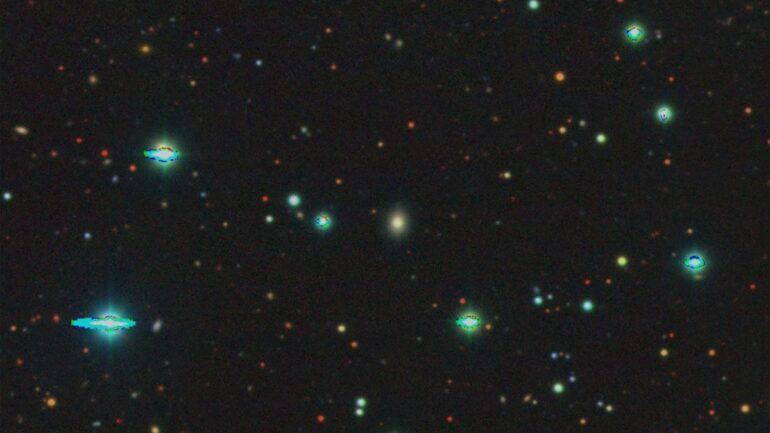TL;DR:
- AI, through the BTSbot algorithm, has identified and classified its first supernova, potentially changing the role of human astronomers.
- Current supernova detection relies on human-computer collaboration, but BTSbot could automate the process.
- This advancement allows astronomers to redirect efforts toward studying the origins of supernovas and refining models.
- Supernovas, especially Type Ia, are challenging to detect despite their brightness.
- BTSbot’s development involved extensive training with historical astronomical images.
- Testing BTSbot on a Type Ia supernova candidate, SN2023tyk, demonstrated its autonomy and effectiveness.
- The integration of AI in supernova discovery promises to advance astronomy and free up human astronomers for deeper cosmic exploration.
Main AI News:
Artificial intelligence (AI) has marked a significant milestone in the field of astronomy by detecting its first supernova, raising questions about the future role of human “explosion hunters.” The breakthrough comes in the form of a fully automated machine-learning algorithm known as Bright Transient Survey Bot (BTSbot). For the first time, AI has successfully identified and classified a supernova, a task that has traditionally relied on human expertise. BTSbot’s developers believe this achievement could revolutionize the way we analyze and categorize these celestial phenomena.
Currently, identifying supernovas involves a collaborative effort between human astronomers and computers. Over the past six years alone, human astronomers have devoted approximately 2,200 hours to visually inspecting and classifying supernova candidates. However, BTSbot has the potential to streamline this process, allowing astronomers to redirect their efforts toward delving deeper into the origins of these explosive events and refining their models.
According to team leader Adam Miller, a professor of physics at Northwestern University in Illinois, “For the first time ever, a series of robots and AI algorithms have observed, then identified, then communicated with another telescope to finally confirm the discovery of a supernova.” He further emphasized the significance of this achievement, explaining that it paves the way for AI to isolate specific subtypes of stellar explosions, ultimately reducing the reliance on human intervention.
By removing humans from the equation, researchers can devote more time to analyzing their observations and formulating new hypotheses to explain the cosmic explosions they observe. This development represents a quantum leap forward in our quest to unlock the mysteries of the universe.
Supernovas: Unveiling Cosmic Spectacles
Supernovas are awe-inspiring cosmic events that occur when dying stars deplete their nuclear fusion fuel. These stars, unable to withstand gravitational forces, undergo a core collapse while simultaneously expelling their outer layers in a dazzling explosion. One subtype, known as Type Ia supernovas, is triggered when a white dwarf star in a binary system accumulates matter from its companion star. This influx of material rekindles the white dwarf, leading to a cataclysmic explosion that annihilates it completely.
What sets these stellar explosions apart is their incredible brightness, which can outshine the combined light of all surrounding stars. Despite their luminosity, supernovas remain challenging to detect due to the vastness of space. Robotic telescopes currently scan the night sky, capturing images of the same celestial regions repeatedly, hoping to spot any transient objects, such as supernovas, that were not present in previous images.
To confirm a candidate as a supernova, astronomers rely on collecting its spectrum, which reveals the elemental composition of the explosion. While some robotic telescopes can collect spectra, this task often requires human intervention. The development of BTSbot, however, offers the tantalizing prospect of automating this process and reducing the need for human oversight.
BTSbot: Training for Stellar Exploration
To equip BTSbot for its groundbreaking role, Miller and his team conducted extensive training using over 1.4 million historical images from nearly 16,000 sources. This extensive dataset included confirmed supernovas as well as other astronomical phenomena such as the temporary flaring of stars, variable stars, and the flaring of galaxies.
Testing the AI’s mettle, the researchers set their sights on a newly discovered supernova candidate, SN2023tyk, believed to be a Type Ia supernova situated approximately 760 million light-years from Earth. The Zwicky Transient Facility (ZTF) robotic telescope initially spotted this celestial spectacle on October 3. BTSbot entered the scene on October 5, identifying SN2023tyk and swiftly collecting its spectrum using the Palomar Observatory’s SED machine (SEDM). Remarkably, BTSbot autonomously shared this information with astronomers on October 7, showcasing its potential to seamlessly integrate into the world of cosmic discovery.
Northwestern graduate student Nabeel Rehemtulla, who co-led the development of BTSbot, summed up the experience, stating, “The beauty of it is that once everything is turned on and working properly, we don’t actually do anything. We go to sleep at night, and, in the morning, we see that BTSbot and these other AIs unwaveringly do their jobs.”
Conclusion:
The successful use of AI in supernova discovery, as demonstrated by BTSbot, signifies a pivotal moment in astronomy. This development has the potential to reshape the market by reducing the reliance on human intervention in celestial observations, streamlining the discovery process, and enabling astronomers to focus on more complex research endeavors. The integration of AI is poised to accelerate advancements in our understanding of the cosmos.

